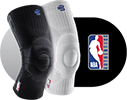1. When it comes to shoe insoles, softer = better.
Completely soft insoles are not only ineffective, but they actually “pamper the problem”. You may find that initially you love the feeling of slipping your foot into a shoe with a soft, cushiony insole, but in reality those types of insoles do nothing to fix the root problem: misalignment of the feet.
A good insole should provide a mixture of supportive, hard structures and softer structures which work together to reshape the alignment of your feet.
2. Insoles should be comfortable right out of the box.
Similar to the theory that “softer = better”, most people think that their insoles should feel comfortable the first time they put them in their shoes. Once you learn the purpose of insoles, to reshape and realign your feet to their anatomical perfection, it should be easy to understand why insoles have a breaking-in period.
Insoles for your feet work much like braces for your teeth, applying pressure to specific areas in order to move them into correct position. That pressure can feel uncomfortable while your muscles, tendons and bones re-learn how to work together to form a proper shape.

Effective insoles redistribute your weight to reduce “hot spots”.
Bauerfeind recommends easing into wearing a new pair of insoles: Start by wearing them for a short time, maybe 30 minutes – 1 hour, and gradually increase as your body gets used to the new shape of your instep. Stick with it, your feet will thank you in the end!
3. Insoles are for people with foot pain.
While shoe insoles certainly do help many people overcome foot pain, that is not the only reason to wear them.

As the children’s song goes, “The foot bone’s connected to the leg bone, leg bone’s connected to the knee bone…” Nature gave our bodies the perfect pattern to deal with movement, especially agility moves like running and jumping. Because the body works together as a chain of muscles, ligaments, and bones, when one part is misaligned it throws the whole system out of whack.
Through realigning the placement of the feet, shoe insoles have been shown to help with pain and inflammation in the knees, hips and lower back. So the next time you experience problems with one of those joints, make sure your feet aren’t the true culprits!
4. Insoles work by bracing your feet.
Just as your insoles cannot work if they’re too soft, they don’t work by bracing, either. Many insoles provide support and stability to the arch while completely ignoring the front and rear of the foot. An effective insole has zones of support and cushioning designed to retrain your muscles and tendons to move in a more natural way.
There is an anatomically-ideal pattern for foot movement while walking/running (spiral torsion): moving from the rear lateral (outside) of your heal at an angle through the center of the arch and finally pushing off at the inside of the big toe. This movement cannot be supported by simply bracing the arch, your insoles should encourage it with the right kind of flexibility.

Read more about Bauerfeind’s WeightFlex® Technology
5. Insoles are only made for athletic shoes.
While the majority of insoles are made to be used in athletic shoes, some insoles are designed to work in a variety of shoes. Bauerfeind offers insoles which can be used in men’s dress shoes and even women’s heels.

Note: From a medical perspective, wearing high heels is not advised. Heels drastically change your gait and posture, and prolonged wearing can have lasting effects. We realize that for purposes of fashion many people still many people choose to wear these shoes, and Bauerfeind especially recommends wearing insoles to minimize the pressure points associated with heels.
6. You only need 1 pair of insoles, as you can move them from one pair of shoes to another.

While it is true that you can theoretically move your insoles from one pair of shoes to another, as humans we tend to forget these things. If you want to see the true effects of retraining your feet and posture, it’s best to ensure the shoes you wear most often have their own, dedicated pair of insoles. This might mean investing in 2 or 3 pairs of insoles.
7. If you have a medical condition, you should always spring for custom insoles.
Custom shoe insoles can cost upwards of $400-$500 per pair, but are they really worth it? Even with the same patient, custom insole craftsmanship can vary from maker to maker. Bauerfeind recommends custom insoles only for the most severe foot conditions. As a point of value, it may be more worth your investment to purchase 4 pairs of quality boxed insoles for the price you would pay for a single custom pair.





